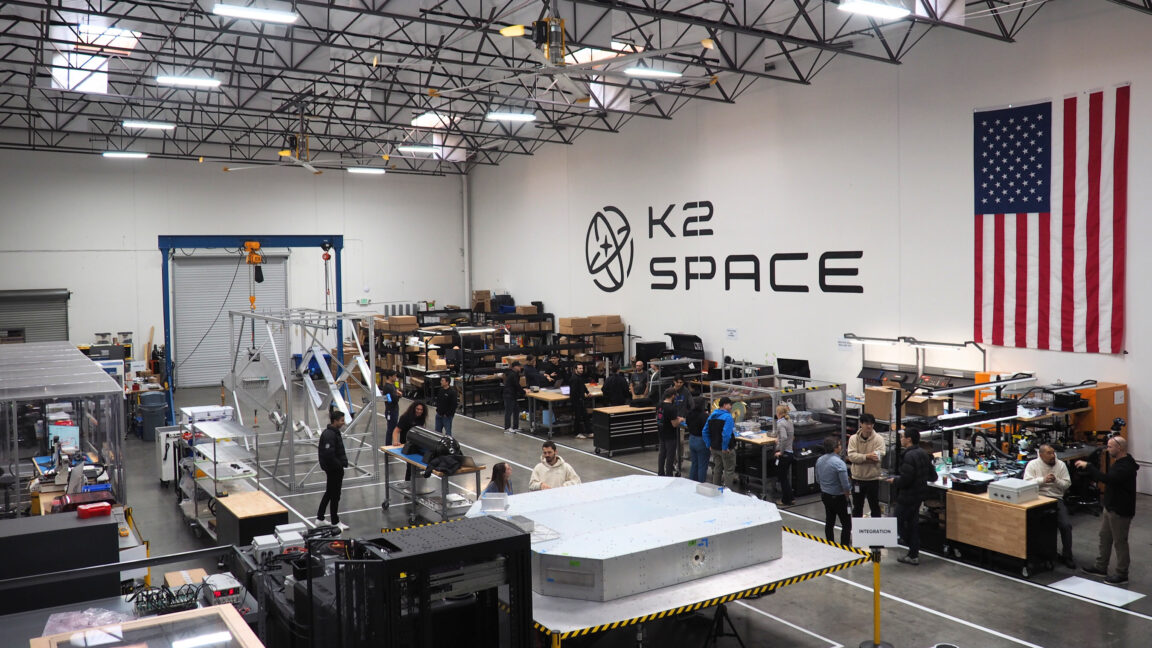
Satellite firm bucks miniaturization trend, aims to build big for big rockets
arstechnica.com
Ru ready for k2? Satellite firm bucks miniaturization trend, aims to build big for big rockets "We decided to go after one of the big problems." Eric Berger Jan 21, 2025 1:04 pm | 5 A view inside the K2 factory. Credit: K2 A view inside the K2 factory. Credit: K2 Story textSizeSmallStandardLargeWidth *StandardWideLinksStandardOrange* Subscribers only Learn moreA potentially disruptive satellite company launched its first spacecraft last week as part of a Transporter mission flown on SpaceX's Falcon 9 rocket.The demonstration mission from a California-based firm named K2 aims to "burn down" the risk of the technology that will fly on the company's first full-sized satellite. So far, so good, but it's early days for the demo flight.Founded a little less than three years ago, K2 seeks to disrupt the production of large satellites by focusing on vertical integration and taking advantage of large launch vehicles, such as SpaceX's Starship and Blue Origin's New Glenn, which can throw a lot of payload into space."We think we're about to go from an era of mass constraints to an era of mass abundance," said Karan Kunjur, co-founder and chief executive of K2, in an interview with Ars.They go small, we go bigBy contrast, over the last decade, much of the satellite industry has gone smaller. Similar to the trend in consumer electronics, in which more computing power and other capability can be packed into smaller devices, satellites have also gotten smaller and cheaper."When we looked at the market, we saw a massive amount of small satellites," Kunjur said. "The small satellite boom figured out how to go cheaper and faster, but it hasn't figured out how to do that without sacrificing capability."Smaller satellites typically sacrifice a lot of power, going from as much as 20 kilowatts down to 1 or 2 kW, Kunjur said. They also often have a smaller aperture (such as a lens in a telescope), reducing the quality of observations. And they have to make difficult trades between payload capacity and on-board propellant.Taking on an industry titanThere has been less innovation in larger satellites.One of the industry-leading large satellite busesa satellite bus is the main structural component of a satellite, upon which payloads are hostedis Lockheed Martin's LM2100 spacecraft. It is a proven vehicle with a payload capacity of more than 1 ton and 20 kW of peak power. It is used for the military's Global Positioning Satellites and other government applications. The LM2100 is a robust satellite capable of operating in geostationary orbit for 15 years or longer.Although the price of this satellite bus is proprietary, various estimates place the cost at between $100 million and $150 million. One reason for the expense is that Lockheed Martin buys most of the satellite's elements, such as its reaction wheels, from suppliers."Lockheed is amazing at doing those missions with really complex requirements," Kunjur said. "But they just have not changed the way they build these larger, more complex spacecraft in the last 15 or 20 years."Vertical integration is the way?K2 aims to disrupt this ecosystem. For example, the reaction wheels that Honeywell Aerospace sells to Lockheed cost approximately $500,000 to $1 million apiece. K2 is now on its fourth iteration of an internally built reaction wheel and has driven the cost down to $35,000. Kunjur said about 80 percent of K2's satellite production is vertically integrated.The company is now building its first "Mega Class" satellite bus, intended to have similar capabilities to Lockheed's LM2100: 20 kW of power, 1,000 kg of payload capacity, and propulsion to move between orbits. But it's also stackable: Ten will fit within a Falcon 9 payload fairing and about 50 within Starship's fairing. The biggest difference is cost. K2 aims to sell its satellite bus for $15 million.The US government is definitely interested in this capability. About a month ago, K2 announced that it had signed a contract with the US Space Force to launch its first Mega Class satellite in early 2026. The $60 million contract for the "Gravitas" mission will demonstrate the ability of K2's satellite bus to host several experiments and successfully maneuver from low-Earth orbit to middle-Earth orbit (several thousand km above the surface of Earth).Although the Mega Class satellite is attractive to government and commercial customersits lower cost could allow for larger constellations in middle- and geostationary orbitsKunjur said he and his brother Neel Kunjur founded K2 to enable more frequent science missions to other planets in the Solar System."We looked at the decadal studies and saw all the mission concept studies that were done," Kunjur said. "There were maybe 50 studies over a 10-year period. And we realized that if NASA funding remains level, we'll be able to do one or maybe two of these. So we decided to go after one of the big problems."So, if we're moving into an era of launch abundance, K2 might just solve the problem of affordable science satellites to launch on all these rocketsif it all works, of course.Eric BergerSenior Space EditorEric BergerSenior Space Editor Eric Berger is the senior space editor at Ars Technica, covering everything from astronomy to private space to NASA policy, and author of two books: Liftoff, about the rise of SpaceX; and Reentry, on the development of the Falcon 9 rocket and Dragon. A certified meteorologist, Eric lives in Houston. 5 Comments
0 Commenti
·0 condivisioni
·51 Views


